
Zoo Atlanta has set up an indigo snake hatching program to reintroduce the snake to its former territories in Alabama and Georgia. This preserve has the longleaf pine habitat the snake flourishes in, and the release program is considered a conservation success story. The first snakes were released in the Apalachicola Bluffs and Ravines Preserve in Florida. In 2017, Auburn University and the Nature Conservancy began a 10-year program of reintroducing indigo snakes to their former range. It has been difficult because captivity is very stressful for indigo snakes, but some programs have had promising results.

They mostly live in southern Florida.Įfforts to preserve this species have focused on breeding them in captivity. Since the destruction of these burrows in North Florida, fewer indigo snakes now live in the northern part of the state. Destroying these burrows left the snakes without shelter. Indigo snakes often share the burrows of gopher tortoises. Another major threat has been rattlesnake hunters who destroyed gopher tortoise burrows to find the rattlesnakes. The species suffered dramatic population declines caused primarily by collectors for the illegal pet trade. The size of the snake’s population is unknown. In 1978, they were listed as a protected species under the Endangered Species Act. Indigo Snake Population & Conservation StatusĪlthough they are listed as “least concern” by the International Union for the Conservation of Nature (IUCN), eastern indigo snakes are considered threatened under U.S. See all of our entertaining and insightful animal articles.

Discover The Largest Snake Ever Found In Georgia!.

Indigo Snake vs Black Racer: What’s the Difference?.Playing Possum: 9 Animals That Play Dead to Survive.Invasive Species in the United States: The Big List of Invasive Animals.51 Snakes Found in Mississippi (6 are Venomous).


 0 kommentar(er)
0 kommentar(er)
